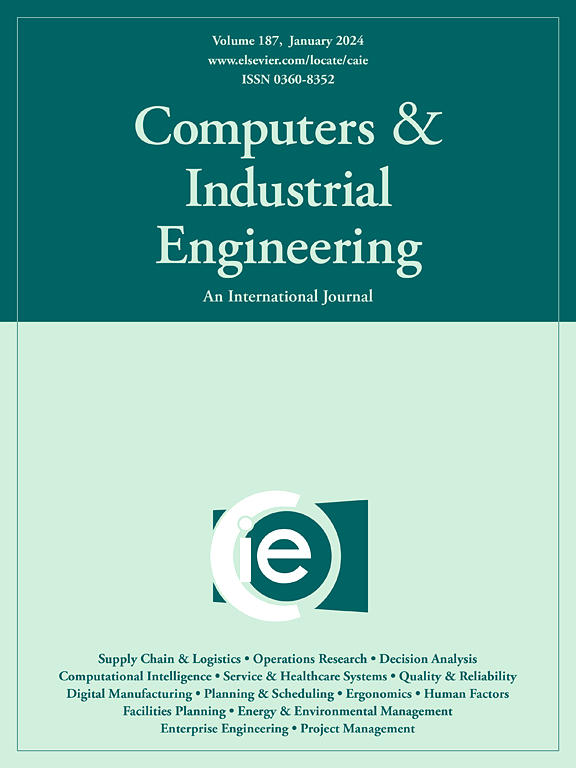Climate risk and green innovation in semi-conductor industry: Do supply chain concentration and resilience matter?
IF 6.7
1区 工程技术
Q1 COMPUTER SCIENCE, INTERDISCIPLINARY APPLICATIONS
引用次数: 0
Abstract
Climate change presents a universal challenge affecting countries on a global scale. Given the exigencies imposed by extreme weather events and environmental degradation, corporations across diverse sectors have embraced green innovations (GI) as a strategy to address the imperatives of climate change adaptation and mitigation. This study examines the complex relationship between climate risks and corporate GI by analyzing data from 146 firms within the Chinese semiconductor industry over the period 2007 to 2022. Employing a combination of Poisson-Pseudo-Maximum-Likelihood (PPML), panel threshold, and moderating effect models, the analysis seeks to uncover the nuanced dynamics between environmental risks and corporate sustainability practices. The findings underscore that both annual and longer-term climate risks, as measured by the climate risk index (CRI), exert a significant promotional effect on GI. Additionally, the study reveals that CRI acts as a stimulus for GI by augmenting R&D intensity, attracting investments in green finance, and enhancing financial flexibility. Furthermore, the study incorporates an assessment of corporate resilience capacity through threshold analysis, shedding light on the pivotal nexus between CRI and GI. This nexus exhibits a pronounced positive association within the intermediate range delineated by two threshold values. Additionally, a moderating effect analysis, taking into consideration supply chain concentration and overall corporate production elements, underscores the reinforcing effect of both supply chain concentration and total factor productivity on the influence of CRI in promoting GI. The study also undertakes a comprehensive exploration of heterogeneity by considering various corporate and regional factors. In light of the findings articulated above, this research puts forth a series of recommendations tailored for managerial decision-making and the policy formulation process.

半导体产业的气候风险和绿色创新:供应链集中度和弹性重要吗?
气候变化是影响全球各国的全球性挑战。鉴于极端天气事件和环境退化造成的紧急情况,各个部门的公司都将绿色创新作为一项战略,以应对适应和减缓气候变化的必要性。本研究通过分析2007年至2022年中国半导体行业146家公司的数据,探讨了气候风险与企业地理特征之间的复杂关系。采用泊松伪最大似然(PPML)、面板阈值和调节效应模型的组合,分析旨在揭示环境风险和企业可持续发展实践之间微妙的动态关系。研究结果强调,以气候风险指数(CRI)衡量的年度和长期气候风险对全球地理变化都有显著的促进作用。此外,研究还发现,CRI通过增加研发强度、吸引绿色金融投资和提高金融灵活性来刺激全球生态环境。此外,本研究还通过阈值分析对企业弹性能力进行了评估,揭示了CRI与GI之间的关键关系。这种联系在两个阈值划定的中间范围内表现出明显的正相关。此外,通过考虑供应链集中度和企业整体生产要素的调节效应分析,强调了供应链集中度和全要素生产率对CRI促进GI影响的强化作用。本研究还考虑了不同的企业和区域因素,对异质性进行了全面探讨。根据上述调查结果,本研究提出了一系列适合管理决策和政策制定过程的建议。
本文章由计算机程序翻译,如有差异,请以英文原文为准。
求助全文
约1分钟内获得全文
求助全文
来源期刊

Computers & Industrial Engineering
工程技术-工程:工业
CiteScore
12.70
自引率
12.70%
发文量
794
审稿时长
10.6 months
期刊介绍:
Computers & Industrial Engineering (CAIE) is dedicated to researchers, educators, and practitioners in industrial engineering and related fields. Pioneering the integration of computers in research, education, and practice, industrial engineering has evolved to make computers and electronic communication integral to its domain. CAIE publishes original contributions focusing on the development of novel computerized methodologies to address industrial engineering problems. It also highlights the applications of these methodologies to issues within the broader industrial engineering and associated communities. The journal actively encourages submissions that push the boundaries of fundamental theories and concepts in industrial engineering techniques.
 求助内容:
求助内容: 应助结果提醒方式:
应助结果提醒方式:


